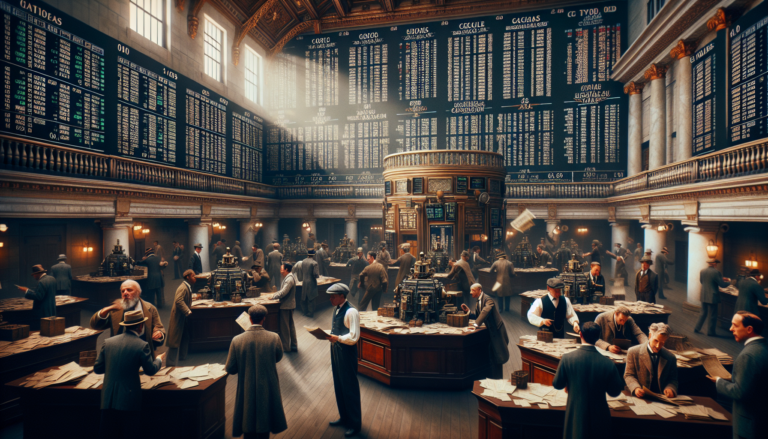Introduction to the 1920s: A Decade of Change
The 1920s, often referred to as the “Roaring Twenties” or the “Jazz Age,” was a decade marked by significant economic, social, and cultural changes in the United States. This period saw unprecedented economic prosperity, technological advancements, and a shift in cultural norms that greatly influenced the American way of life. Understanding the factors that shaped this era is crucial to comprehending what made Americans so willing to engage in stock market speculation in the 1920s.
Economic Prosperity and Its Impact
The post-World War I period ushered in an era of economic boom in the United States. The 1920s witnessed a surge in industrial production, consumer spending, and financial speculation, particularly in the stock market. The war had stimulated the growth of many industries, and the subsequent peace allowed for a thriving economy. This prosperity led to increased disposable income for many Americans, who eagerly invested in the booming stock market.
Wall Street became the symbol of the nation’s economic success. The stock market experienced tremendous growth, with the Dow Jones Industrial Average soaring from 63 points in 1921 to a peak of 381 points in 1929. The promise of quick profits and the belief in the endless potential of the market attracted investors from all walks of life, from wealthy businessmen to ordinary citizens.
Cultural Shifts and the Jazz Age
The economic prosperity of the 1920s was accompanied by significant cultural changes. The Jazz Age, named after the popular music genre that emerged during this period, represented a break from traditional values and a celebration of modernity, individualism, and self-expression.
The rise of the “flapper” culture exemplified the changing roles and expectations of women in society. Flappers were young women who challenged traditional gender norms by embracing a more liberated lifestyle, characterized by shorter hemlines, bobbed hair, and a carefree attitude. This cultural shift contributed to a general atmosphere of optimism and a willingness to take risks, including in the stock market.
Factors Contributing to Stock Market Speculation
Technological Advancements and Media Influence
The 1920s saw significant technological advancements that transformed American society and contributed to the stock market boom. The widespread adoption of radio and the growth of the film industry played a crucial role in shaping public opinion and fueling consumer desires.
Radio broadcasts and newspapers disseminated information about the stock market, often portraying it as a path to quick wealth. The media’s positive coverage of the market, coupled with the endorsement of influential figures, encouraged more Americans to invest in stocks.
Moreover, technological innovations in manufacturing and transportation, such as the assembly line and the automobile, boosted industrial productivity and created new investment opportunities. The promise of high returns in these emerging industries further enticed Americans to participate in the stock market.
Rise of Consumerism and Mass Culture
The economic prosperity of the 1920s fueled a consumer revolution in the United States. The rise of mass production and advertising led to the creation of a consumer culture that emphasized the acquisition of goods and the pursuit of leisure activities. Americans were encouraged to buy the latest fashions, appliances, and automobiles, often on credit.
This culture of consumerism was closely tied to the stock market boom. Many Americans believed that investing in stocks was a means to achieve the financial success necessary to participate in the consumer lifestyle. The desire for material goods and the fear of missing out on potential profits drove more people to engage in stock market speculation.
Urbanization and Migration Trends
The 1920s witnessed significant urbanization and migration trends that contributed to the stock market frenzy. The Great Migration saw millions of African Americans move from the rural South to the urban centers of the North and Midwest in search of better economic opportunities and social freedoms.
The growth of cities and the concentration of wealth in urban areas created a fertile ground for stock market speculation. Urban dwellers, exposed to the excitement and opportunities of city life, were more likely to be influenced by the prevailing culture of consumerism and financial risk-taking.
Moreover, the influx of immigrants from Europe and the migration of rural Americans to cities expanded the pool of potential investors. Many newcomers to urban areas saw the stock market as a means to quickly integrate into the American dream of prosperity and success.
Social and Cultural Dynamics of the 1920s
Prohibition and Its Societal Impacts
The 1920s were marked by the implementation of Prohibition, a nationwide ban on the production, sale, and transportation of alcohol. While intended to promote moral and social reform, Prohibition had unintended consequences that shaped the cultural landscape of the decade.
The rise of speakeasies and the glamorization of bootlegging created an underground culture of rebellion and excess. This atmosphere of defiance and indulgence spilled over into other aspects of life, including the stock market. The willingness to flout the law and take risks in the pursuit of pleasure and profit became a hallmark of the era.
The Role of Flappers in Changing Social Norms
The flapper movement, which emerged in the 1920s, represented a significant shift in social norms and gender roles. Flappers were young women who embraced a more liberated lifestyle, challenging traditional expectations of femininity and propriety.
The flapper culture symbolized a broader rejection of old values and a embrace of modernity and individualism. This mindset extended to the realm of finance, where taking risks and pursuing individual success became increasingly acceptable and even celebrated.
Moreover, the growing independence and economic power of women during this period meant that more women were entering the workforce and making their own financial decisions. The increased participation of women in the stock market contributed to the speculative frenzy of the 1920s.
The Harlem Renaissance and African American Culture
The Harlem Renaissance was a cultural movement that flourished in the 1920s, centered in the predominantly African American neighborhood of Harlem in New York City. This movement celebrated black identity, creativity, and intellectual achievement, and had far-reaching impacts on American culture as a whole.
The Harlem Renaissance was fueled, in part, by the Great Migration of African Americans from the rural South to the urban centers of the North and Midwest. This demographic shift created a concentration of black talent and energy in cities like New York, Chicago, and Detroit.
The cultural vibrancy and optimism of the Harlem Renaissance contributed to the general atmosphere of the 1920s, which encouraged experimentation, self-expression, and risk-taking. While the opportunities for African Americans to participate in the stock market were limited by systemic racism and economic inequality, the spirit of the Harlem Renaissance nonetheless reflected the era’s embrace of change and possibility.
Conclusion: Legacy of the 1920s in American History
The 1920s left an indelible mark on American history, shaping the nation’s economic, social, and cultural trajectory for generations to come. The decade’s legacy is one of both incredible prosperity and devastating collapse, as the stock market boom of the 1920s ultimately gave way to the crash of 1929 and the Great Depression.
However, the factors that made Americans so willing to engage in stock market speculation during this period – the economic prosperity, technological advancements, cultural shifts, and social dynamics – had lasting impacts beyond the realm of finance. The 1920s saw the emergence of new forms of media, entertainment, and consumer culture that would define American society for decades to come.
Moreover, the social and cultural changes of the 1920s, from the flapper movement to the Harlem Renaissance, set the stage for future struggles for civil rights and gender equality. The decade’s spirit of experimentation, individualism, and rebellion against tradition would resurface in various forms throughout the 20th century.
In conclusion, understanding what made Americans so willing to engage in stock market speculation in the 1920s requires a holistic examination of the economic, social, and cultural forces that shaped the era. By exploring these factors, we gain insight not only into a pivotal moment in American financial history, but also into the broader cultural and social dynamics that continue to influence the nation to this day.
See also:






